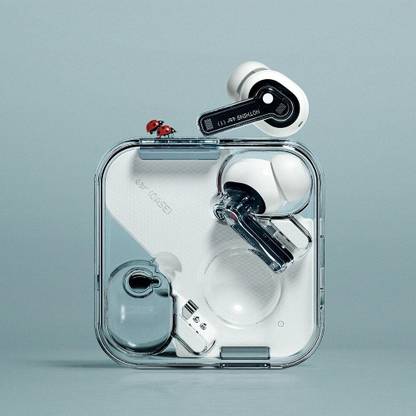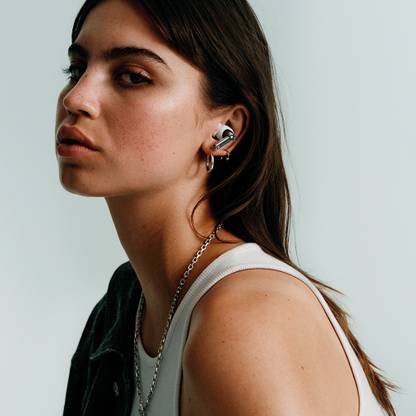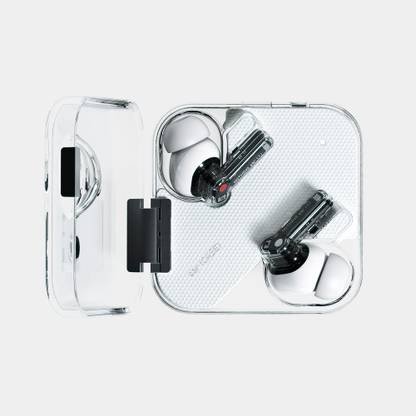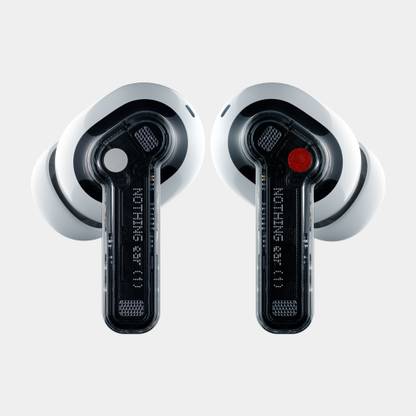
It is not every day that a new consumer tech brand is born with big dreams and lofty ambitions. Now, Carl Pei might want you to believe that it is Nothing. But, it is definitely something…interesting and exciting.
For the uninitiated, Nothing is a new company that wants to eschew the entrenched conventions of building consumer tech products. The brand is a brainchild of OnePlus co-founder Carl Pei and it is backed by several high-profile investors, including Google Ventures. So, you know they aren’t fooling around.
The first product in their ecosystem is a pair of truly wireless earbuds – the Ear 1. It takes a unique approach to design. But, is it only form over function?
Stay with me to find out the answer to that question and more in my in-depth review of the Nothing Ear 1 and comparison with many other earbuds in the same price range.
Nothing Ear 1 – Design, Fit, and Comfort
One must admit, in a sea of sameness, the Nothing Ear 1’s design is an outlier. It is edgy, it is innovative, and it is absolutely stunning to look at. This ‘Retro Futuristic’ design language not only looks attractive but also brings certain real-life usage enhancements.
Starting with the square case, you will see that Nothing has adopted a transparent plastic shell on the exterior. This means, your buds and the LED indicator are clearly visible through the see-through plastic. The case itself feels extremely sturdy and well put together. And, the size feels just apt. Now, there is a Type-C port for charging and a button for initiating the pairing mode. What I like about the design is there is a very sturdy metal hinge holding the lid and the base together. But, even after babying the review unit, the case has started showing scrapes and scuffs on the external plastic. This is unavoidable considering plastic, as a material, tends to scuff and scratch easily. This means Nothing Ear 1’s case is not going to age well.

As for the magnet that holds the lid and the base together, it has the right amount of force. But, you cannot flip it open with your thumb like you can the Realme Buds Air 2’s case or the AirPods Pro’s case. Although, that is an inherent downside of the design and not necessarily something that should sway your buying decision. Because, even otherwise, thanks to the right choice of magnetic force, the opening and closing motion is extremely smooth and fluid. And, such attention to detail is also apparent in a couple of other design choices.
For example, there is a crater on the top lid that keeps the earbuds in place inside the case. Now, I don’t know if it is intentional, but this indentation helps you grip the case even better. On the flip side, the White and Red dot indication points on the earbuds are definitely intentional. Red is for the right earbud and White is for the left one. You have this color labeling on the groove as well, making it easy to line up the right earbud to the right groove. Plus, the magnetic force that pulls the earbuds in, when you throw it inside the case, feels extremely satisfying.

Coming to the design of the earbuds themselves, the housings are carved in White plastic which is further attached to a transparent stem. This dual-tone design is immediately attractive. And, the black unit inside the stem, possibly holding all the components, looks extremely gorgeous. I must say this when you wear them in your ear, they stand out. And, if the Ear 1 becomes popular, it has the potential to be an iconic design.
That’s not it. The angular stem design ensures that it doesn’t collide with the antitragus or the arch-shaped cartilage that protrudes out of your ear. It is by far, the most comfortable pair of truly wireless earbuds I’ve tested till date after finding the right tip size. Anyway, you get three liquid silicone tips in the box. Fun fact: Liquid Silicone is the same material used by Apple to build its official cases. I found the right fit with the largest size tip and wearing these buds for hours on end caused absolutely no fatigue whatsoever.

Nothing Ear 1 – App Support and Controls
What is also great about the stem design is that it is flat on the outside. This means that tapping or swiping for controls is a breeze. The controls include:
- Double-tap to play/pause the music.
- Triple Tap the left earbud for the next song and the Right one for the previous one.
- Tap and Hold to switch through the Transparency, Normal, and Noise Cancelling modes.
- And finally, swipe up and down to increase/reduce the volume.
Of these controls, you can configure the Triple Tap and Tap Hold gestures to your liking.
After a couple of firmware updates, I found the controls absolutely responsive. No complaints, whatsoever. But, the automatic Play/Pause function is not as responsive. It was pretty iffy and needs a couple more software updates before it can perform optimally. Also, while there is support for Fast Pairing on Android, it hasn’t hit my review unit yet. I think Realme’s audio products get it absolutely right.

The app is well designed and intuitive. You can see the dot matrix text just about everywhere. With the app, Nothing is very open to customization. You can even change the color of the LED light if you wish. Even something as simple as changing the EQ has been simplified to make it easier for more people to understand by labeling it ‘More Treble’ and ‘More Bass.’ Plus, there is this really cool Find My Earbud feature that plays a loud sound in your earbuds so you can find them, provided they are in Bluetooth range.
Overall, Nothing Ear 1’s app is possibly the best-designed app out there. It might not have the feature set of the Realme Link app or Samsung’s Galaxy Wearable app, but there’s still time. And, I did notice one thing. The app is called Ear 1. Does that mean, Nothing will have different apps for individual products in the future? Well, that would be counterintuitive no?
Nothing Ear 1 – ANC and Transparency
Now, talking about the active noise canceling feature available on the Nothing Ear 1, it is pretty good. But, it still struggles to completely cut out the noise of the overhead fan in my room or the traffic on the road. Which, the more expensive pair of earbuds like the Sony WF-1000XM3 or the AirPods Pro can do a better job of.
But yes, the Ear 1 does have class-leading ANC performance if the class is defined as TWS buds under Rs 10,000. In comparison, the Buds Air 2, Oppo Enco W51, Oppo Enco X, definitely fall short. As for the transparency mode, the Ear 1 does a good job of amplifying the environmental noise and the Buds Air 2 is equally good.
Nothing Ear 1 – Sound Signature
I am absolutely happy to report that Teenage Engineering’s influence in tuning the sound signature definitely helps. I used a Samsung Galaxy S21 Ultra and an iPhone 12 for testing the sound, with Apple Music as my preferred streaming source.
The Ear 1’s 11.6mm graphene drivers, with support for the SBC and AAC codecs, do offer a Balanced tuning. But, what really stands out is the spaciousness of the sound thanks to the 0.34cc chamber. The sound staging is absolutely fantastic in Roundabout by Yes. You get both vertical height and horizontal depth, which is a rarity in truly wireless buds. It is right up there with the Oppo Enco X and the Buds Pro when it comes to the airiness of sound. But yes, the Galaxy Buds+ and the Realme Buds Air 2 do come close in terms of the sound staging.
The mid-bass slam on the Ear 1 is fairly tight, but the sub-bass decay is pretty evident. For an overall better bass attack and slam, the Lypertek Tevi would easily be my TWS of choice. The Galaxy Buds+ has a clean bass tuning as well but it lacks the kind of impact that the Tevi or even the Ear 1 offers, for that matter.
While the mids are very well-tuned on the Ear 1, there is an upper mid-range spike in certain songs. You can hear that in the drum slam in the basic percussion loop running in the background of Adiye from Rahman’s Kadal. But, the same problem exists in the Lypertek Tevi as well. These mid-range spikes make an earphone sound shouty. This is why the absolutely sublime mids-tuning of the Galaxy Buds+ is worth highlighting here.
As for the treble, there’s a good amount of extension, with a clean texture as well. But, the roll-off happens sooner than the Lypertek Tevi. Levi's treble performance is the best in this price range. Although talking about texture and tonality, the Galaxy Buds+ just trumps the competition. The Ear 1 is pretty good too, but I felt certain instruments didn’t offer the same kind of tonal fidelity as the Galaxy Buds+ or the Lypertek Tevi.
Imaging, on the other hand, is the best on the Ear 1 and the Buds+. You can clearly identify each instrument in the penultimate section of Do I Wanna Know by the Arctic Monkeys. In comparison, the Tevi actually struggles with imaging in complex tracks and even something like the Buds Air 2 sounds better.
All in all, you get a very clean sound on Ear 1 that could very well be one of the best sounding products under Rs 10,000. I’d say the sound signature is right up there with the Oppo Enco X, Lypertek Tevi, and the Samsung Galaxy Buds+. But yes, the Galaxy Buds Pro continues to be my gold standard for best sound truly wireless earbuds even today.
By the way, I made an easy to comprehend chart of all the best truly wireless earbuds I’ve tested under Rs 7,000...
Nothing Ear 1 – Mic Performance
The Ear 1 has three HD mics with something called a Clear Voice technology for calls. I tested the sound quality alongside four other truly wireless earbuds. The noise-canceling tech works well but it tends to color the human vocal, due to which my voice sounds slightly robotic. All things considered, when you talk about a good balance of ENC and good sound quality in calls, the Lypertek Tevi is the best option on TWS buds under Rs 7,000. Anyway, take a listen for yourself to judge the quality.
Nothing Ear 1 – Battery Life
Nothing promises 4 hours of battery life from the buds with ANC on. In my testing, I got around 3 hours and 48 minutes. And, you get about 5.7 hours with the ANC off. Additionally, Nothing claims 34 hours of battery life on the case with ANC off and 24 hours with ANC on. You also get wireless charging support on the case, for what it is worth.
But, is this the best battery performance? Not really. The Lypertek Tevi and the Samsung Galaxy Buds+ are clearly the battery champs. But, do keep in mind that both don’t offer ANC.
Should you buy the Nothing Ear 1? And, is it revolutionary?
The Ear 1 could’ve been easily priced higher if Nothing wanted to. But, at Rs 5,999, the Ear 1 offers fantastic value with a well-balanced sound signature, decent battery life, iconic and premium design, and a snug fit. I’d easily recommend these to many folks. And, I don’t think it is only a “form over function” product.
But, the bigger question is – does it create a revolution in the world of consumer tech products? Maybe, not so soon. A revolution generally takes time. And, we must realize, this is just the first product. For Nothing’s vision to be clearly defined we need a few more products in their ecosystem before we can completely judge its efficacy.
Although, let’s quickly take a look at the competition:
Realme Buds Air 2
The Buds Air 2 is much cheaper than the Nothing Ear 1, but it offers the same features. It is surprising how much value Realme packs into its product. However, for all the ANC goodness and Realme Link app polish, the Nothing Ear 1 offers a way better sound signature and a design worth flaunting.
Oppo Enco W51
The Enco W51, when it launched, was the most affordable truly wireless buds with ANC. Now, the market has evolved. And, it is slowly showing its age. In every single parameter, the Nothing Ear 1 is a better product for just Rs 1,000 more.
Samsung Galaxy Buds+
Now that the Galaxy Buds+ has dropped in price drastically, it is a fantastic option for many folks looking for a great sound signature. If you don’t care much about ANC, this is a good alternative. And, I prefer the sound tuning on the Buds+ slightly better than the Ear 1. But, the Ear 1 offers ANC and that just seals the deal (pun intended). Also, the passive noise isolation is not good on the Buds+, which doesn’t bode well for its sales.
Lypertek Levi
The Tevi was a breakthrough pair of truly wireless earbuds when it launched. But today, I realise it is not as comfortable and the sound signature has not aged well. And, it is still a fantastic option, considering it has the best battery life and mic. But, the Nothing Ear 1 beats it with ANC support, a gorgeous design, and a more spacious sound.
So yeah, that was my deep dive on the Nothing Ear 1. What did you folks think?





![NaturalReader Pro Free Activation Key 2021 [Ultimate] Free Download NaturalReader Pro Free Activation Key 2021 [Ultimate] Free Download](https://blogger.googleusercontent.com/img/b/R29vZ2xl/AVvXsEhfOINu7-x_LxJ2zWx5HWi6LW7W9DUOAKpR1srYYMus565xWm-UpX0qQVAx3gkpkq-XPtDG53meA5xyzzBxaLdhMdO5fOhtG3GgargVbp9sGEby2YjO_2DmIcmjiohiVMnQM6SG3wruDgg/s72-c/NaturalReader-15-Crack-With-Activation-Key-2017-Final-Free-Download-300x127.png)



0 Comments: